Defensive tactics
The aim of all defensive tactics is to prevent the opposition from scoring and win the ball back. Different tactics balance the risk of giving a goal away with the chance to win the ball back and attack.
Two and Two:
The defending team forms a tight "christmas tree" formation in front of the goal keeper. The two back players should be facing slightly towards the centre of the goal and have the noses of their boats close together. The two top players should set up infront of this inside the 6 metre slightly further apart.

The aim of this defence is for the two back players to keep the area between them, directly under the goal, free from attacking players. Ideally they will have attacking players outside them not pointing towards the goal. The two top players take the speed off of incoming attackers and help to push them towards the outside, protecting the very centre of the defence. In addition if the oppurtunity arises a top player can chase the ball but only if they believe they can win it.
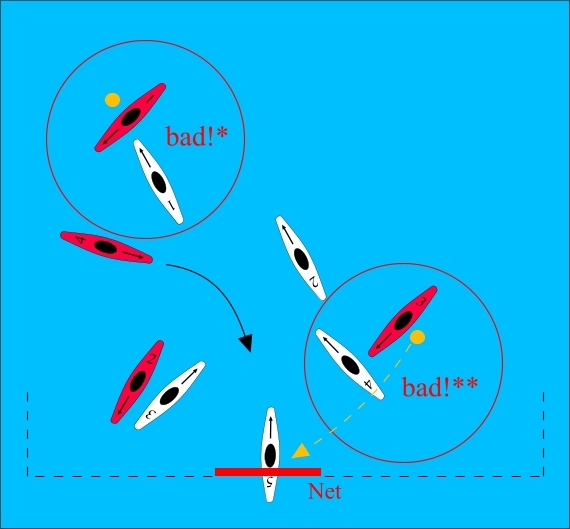
* Player 1 has left the formation to chase a ball which opposition player 1 has under control on the opposite side, leaving a gap for opposition player 4 to paddle into which could result on an undefended shot on goal.
** Player 4 has been lazy, and left opposition player 3 close to and facing goal, with the ball. Although player 4 and the keeper can attempt to block a shot with paddles, opposition player 3 is in close and has a better chance of scoring than they would if they had been turned away by player 4.
Chasing two and two:
Similar to a two and two however more agressive and so is used generally when your team is down a goal or the opposition is weaker. In this defense the top two players have much more freedom to chase after the ball and put pressure on the attackers preventing them from building an attack. Generally only one of the top two players should be chasing the ball at once while the other sits at the top and responds to threats. If the ball is switched or the chasing defender gets tired they can switch with the other top player to continue the pressure.
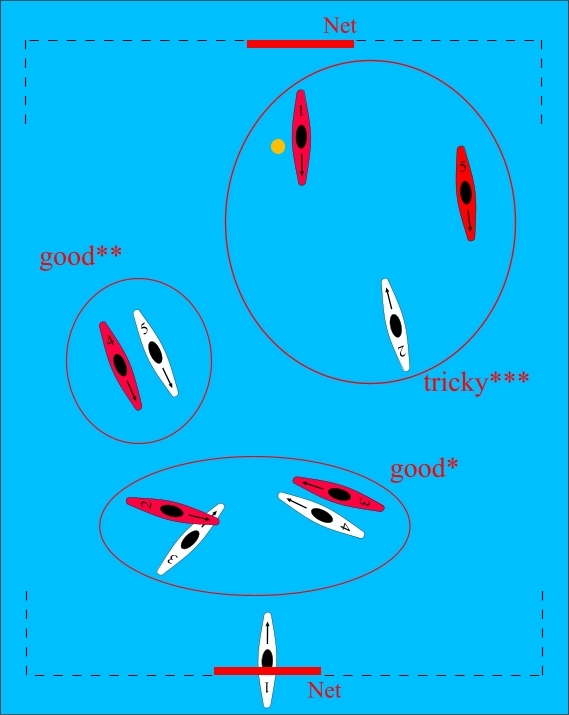
* Players 3 and 4 have kept opposition players 2 and 3 facing away from goal and under pressure.
** Player 5 is marking opposition player 4, is able to block a pass from opposition player 1 and is facing the same way as opposition player 4 so should be able to stay with them easily.
*** Player 2 is standing off and looking to force a pass from opposition player 1 while not leaving opposition player 5 unmarked. They can hope to block a pass with their paddles, or perhaps feign chasing opposition player 1 to force a pass to opposition player 5, but be ready to turn quickly and tackle opposition player 5. Again, this is not ideal and requires some skill and judgement, and probably some luck too!
Three and one:
A very solid defence with three players lined up infront of the keeper and one top player. The two outer players point slightly inwards and ensure that no attackers can get between them and the central player. The central player covers any players that to manage to squeeze into the middle and suppourts whichever side is being overwhelmed. The top player takes the speed off of attackers driving into the zone without getting compressed themslves.

The key to this defence is maintaining a tight shape with good communication without becoming to compressed and being driven out from under the goal. If an outer player is being overwhelmed then the central or top player could switch with them if the situation allows to prevent the defence collapsing.
Five out:
An aggresive defence to use in the final minutes if you are still losing. Each defensive player man mark an attacker and attempts to win the ball. The aim is to put the attacking team under a lot of pressure and force mistakes. Every player must stick to their man and try to stay goal side to prevent a quick break. Be carefull of Illegal jostles when playing five out!
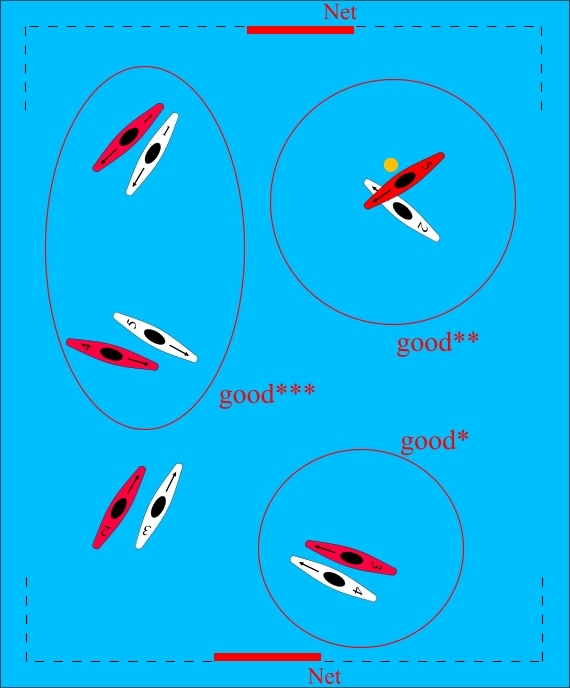
* Player 4 is goal-side of and facing the same way as opposition player 3. It is therefore difficult for player 3 to out-run player 4 since they will both be paddling forwards and if opposition player 5 passes to opposition player 3, a shot is awkward and player four has a chance of blocking it.
** Player 2 has gone under opposition player 5 to attempt a tackle, but remained facing about the same way as opposition player 5 so it is difficult for opposition player 5 to get away without being followed by player 2.
*** Players 1 and 5 are positioned such that they can block a pass from opposition player 5 to opposition players 1 and 4. Players 1 and 5 are also facing the same way as the opposition players they are marking, so escape is difficult!
Attacking tactics
Attacking is less about a single tactic and more about a collection of moves to work sace in the defense. While there are certain individual tactics the general rule that remains throughout is that you can't score without the ball. As a result it is better to continue to pass and wait for an opening than to take long shots (if the keeper is in position) or shots through two or more paddles. The key to a good attack is making sure there are always passing options.
Clear out:
Two attacking players drive down one side of the pitch and each drive a player across the face of the goal (remeber you cant jostle continuosly more than 2m) to create an opening for another attacker to drive into.
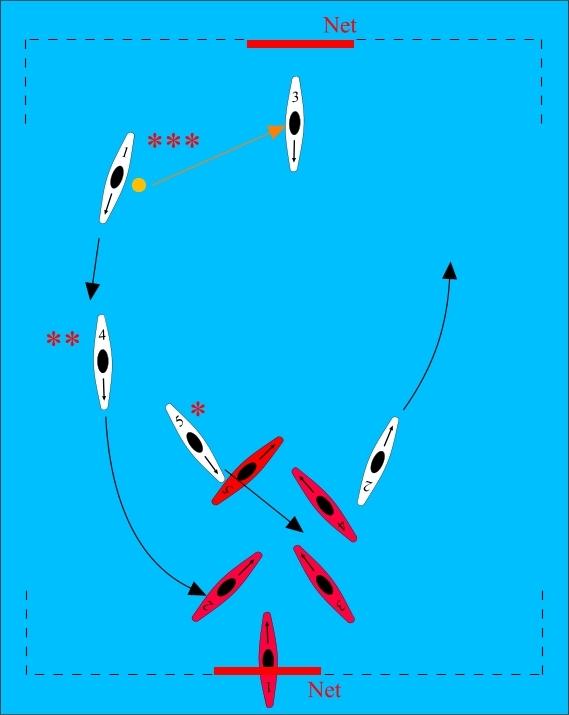
*Player five starts to drive the front two zone players across, and keeps them occupied. Player two has come out from attacking the zone to help player three keep possession of the ball at the back.
**Player four paddles in to start driving the rear two players across and away from their goal line.
***Player one gets rid of the ball and starts following player four at a leisurely pace.
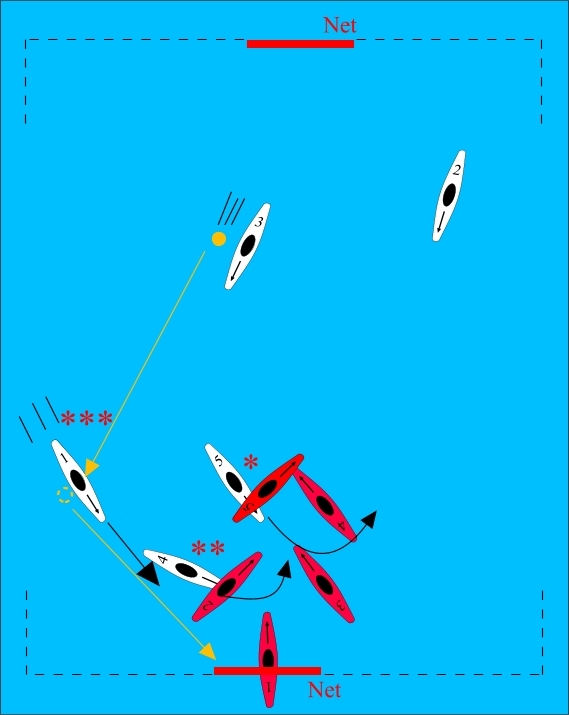
* and ** Players four and five continue driving hard across and out of the opposition zone, trying to occupy the opposition players, create chaos, keep their paddles down in the water etc., while preparing to get out of the zone and back to defence in case of a counter attack.
*** Player one accelerates, approaches the goal from behind player four, at top speed, receives a quick pass from player three and shoots.
If that doesn't work than the ball can be recycled and another attack tried.
Star:
The aim of a star attack is to draw the defence to one side of the pitch and move the ball to the opposite side for a free shot. Generally all 5 attackers will line up and starting from one side of the pitch sprint at the defence in a staggered line. Just before they hit the defence they should pass the ball along the line to the next attacker. In this way the defence will be broken up and drawn to one side of the pitch as the ball is moved to a player moving at speed on the other side.

There are many variations of a star attack circulating the ball around the outside of the defence while players try to create an opening. This could be done through a clear out, or by having one or two players in the middle of the defence, spinning, trying to create a hole.